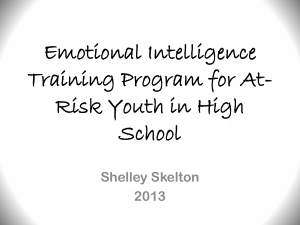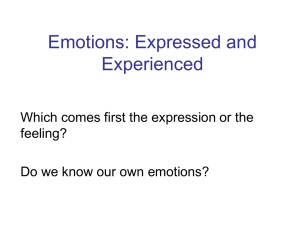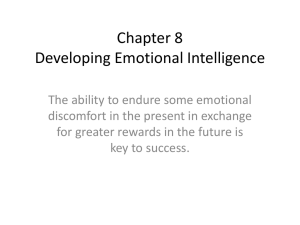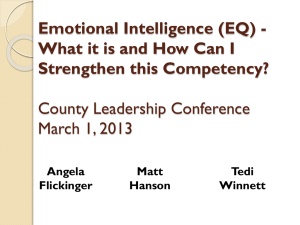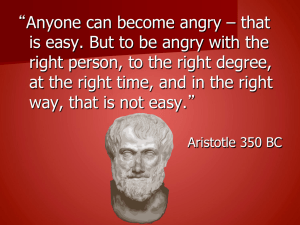Emotional Intelligence and At
advertisement
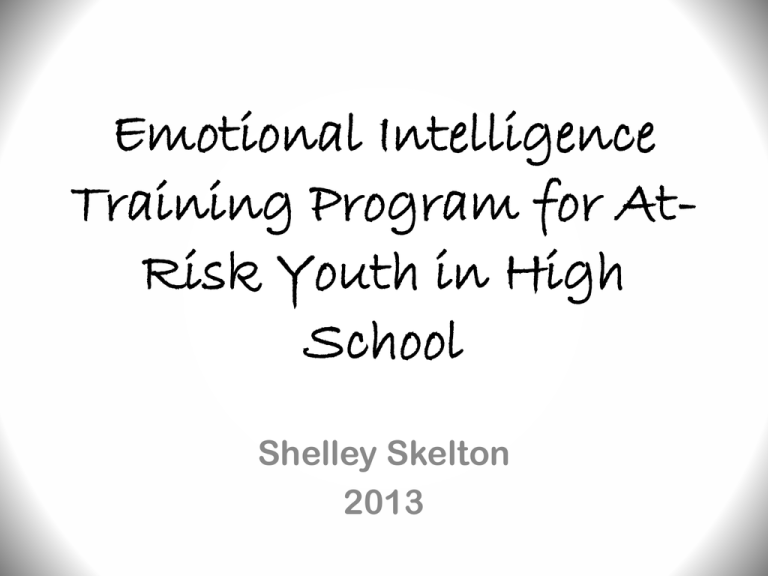
Emotional Intelligence Training Program for AtRisk Youth in High School Shelley Skelton 2013 Presentation Format • • • • Introduction to Emotional Intelligence Rationale to use this program in schools Review of the program Practical information about program implementation • Questions and discussion •What emotions have you experienced in the past 24 hours? Compare situations in which you react to those in which you respond. What emotions do you experience most often and how do you express them? •What triggers your emotional reactions? People? Places? Times? Words? What is emotional Intelligence? • Self-awareness & developing a positive sense of self-worth • Problem-solving • Emotional management / Impulse control • Decision-making • Relationship-building / Empathy / Social Skills • Taking responsibility for one’s actions What is the connection? At-risk youth Low EI Unsuccessful in school Disengaged Disconnected from teachers & peers Poorly developed sense of identity Struggle with relationships Negative attitudes Inexpressive What is the connection? • http://www.lifetrack.com/lifetrack/en/concepts/turning_mindwheel.jsp E I Training Program • Level I • Level II • Level III Self-awareness Emotion Management Relationship Building Level I: Self-awareness • • • • • 1. How the brain works 2. Identification of emotions 3. Emotional triggers 4. Positive self-regard 5. Application of personal awareness Cerebral Cortex: Complex Thought Limbic System: Emotions Hippocampus: emotions & memory Amygdala: emotional control & fear control Hypothalamus: regulates fear & aggression The Amygdala • Reptilian brain • Fight or flight responses. • Gate keeper of the brain, judging each new sensation to be a threat or safe. • When senses danger, sends out an alarm puttingthe entire body on alert. Emotional Hijacking • We feel before we think; everything that we sense has already been filtered through our emotional brain. • When danger is sensed, we react emotionally first before the information has reached any part of the cerebral cortex that allows us to process and think rationally • When what we sense reminds us of a past threat, we react with the same intense emotions; we may not even be aware of the memory that has been triggered. Withstanding the Hijack • In order to think rationally and respond rather than react emotionally, we can need to allow the information to reach the rest of the brain. • We can do this by becoming aware of our emotional triggers and learning to take a moment before reacting. • These skills are key components of Emotional Intelligence. References • Bear, M. (2009). Homerbrain. Retrieved April 10, 2010, from http://talentedapps.files.wordpress.com/2009/03. • Bionoid (2008). Limbic system. Retrieved April 10, 2010, from http://bionoid.net/images/research/limbic.system.gif. • Broderic, P., & Blewitt, P. (2010). The life span: Human development for helping professionals (3rd ed.). Boston: Pearson. • Goleman, D. (2005). Emotional intelligence: Why it can matter more than IQ. New York: Bantam Books. • Seeley, (2010). Cerbral cortex. Retrieved April 10,2010, from http://theunjustmedia.com/Islam/Science/ch1-1-dimg/jpg. Emotions Session 2 Coping with Emotions • We typically deal with emotions one of four ways: • 1) exaggerating the emotion so that we are overwhelmed by them and lose control; • 2) accepting the emotion and not try to regain control; • 3) substituting the emotion with something more comfortable like distractions; or • 4) managing the emotion through self-awareness. Seven Basic Emotions • Anger • Happiness • Fear • Disgust • Surprise • Love • Sadness Which emotions do you feel most often ? % of the day • • • • • • • Anger Happiness Fear Disgust Surprise Love Sadness why? Anger • Blood rushes to our hands so we can fight. • It can be an expression of frustration, stress, anxiety, loss, confusion, embarrassment, jealousy, rejection, threat, etc. • It is one of the most dangerous emotions because it is energizing, and the more often we are angry, the less arousal we need to stay in this state. Anger builds momentum. Fear • Blood rushes to our arms and legs so we can run or fight. • It immobilizes us and forces us into fright, flight or freeze. • It is connected to worry, anxiety, stress, nervousness, panic, paranoia, and phobias. • It is sometimes expressed as anger. Sadness • Metabolism slows, giving us time to mourn. • It comes from not getting what you want or a fear of what might happen. • When sad, many people try to isolate themselves, but this cuts us off from resources to get over the sadness. • It is connected to depression, shame, disappointment, regret, guilt, embarrassment, and insecurity. References • Burande, A. (2010). List of human emotions. Retrieved April 13, 2010, from http://buzzle.com/articles/list-ofhuman-emotions.html. • Goleman, D. (2005). Emotional intelligence: Why it can matter more than IQ. New York: Bantam Books. • Microsoft Office Word (2007). Anger. Retrieved April 10, 2010, from clipart. • Microsoft Office Word (2007). Fear. Retrieved April 10, 2010, from clipart. • Microsoft Office Word (2007). Sadness. Retrieved April 10, 2010, from clipart. Level II: Emotion Management • • • • • 1. Impulse control 2. Stress management 3. Anger management 4. Managing sadness 5. Problem-solving Level II Summary • Emotional management is about how our thoughts, feelings and behaviours impact one another • We can not control our emotions, but with awareness, we can decide how long we experience them and how much they can impact our actions. • Level II addresses: • Impulse control Anger management • Depressive thinking Stress management Impulse Control • responding instead of reacting • recognizing the trigger and the physiological reaction and then finding a way to control your response Anger Management • Anger can have the snowball effect because it can gain momentum from small triggers and when one has an existing level of anger. • Venting often does not get it out of your system; instead it gets stronger. • Managing anger could mean focusing on an incompatible (opposite emotion), using relaxation techniques, or using an awareness of triggers as a cue to walk away. Level III : Relationship Building • Active listening • Empathy • Awareness of others’ feelings • Open topics and conclusion Depressive Thinking • Sadness is the emotion that people try to avoid the most. • People often isolate themselves when sad, which disconnects them from supports. • Laughter, exercise, small successes, and helping others can all help in counteracting sadness. • We often feel sad when we hold on to hurt feelings rather than expressing them. Stress Management • Indicators of stress include: neck and back pain, headaches, overreaction, and change in sleep or appetite. • Worrying plays a part in stress and anxiety. It can create a cycle of negative thinking. • One major source of stress is how we perceive things. • Ways of coping with stress, relaxation techniques, proper nutrition, exercise and sleep. References • Goleman, D. (2005). Emotional intelligence: Why it matters more than IQ. New York: Bantam Books. • Institute for Health and Human Potential (2005). Mindful morning notes: A path to emotional intelligence. Author: Wayne, Illinois. • Stein, H., & Book, H.(2006). The EQ edge: Emotional intelligence and your success. Mississauga, ON: John Wiley & Sons, Canada. Practicalities of the Program • • • • • • Recruitement Advertising Food Time Parent Involvement Location Questions
